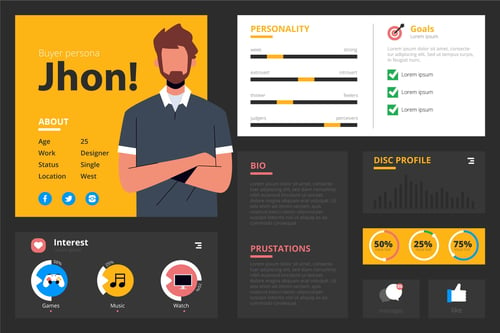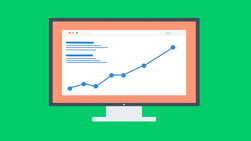Index Content
If you have an online business, a website, a blog where you publish content periodically, you will have heard about SEO positioning. SEO here, SEO there... Surely every day you deal with this word in your business, as it is the most important thing to be positioned correctly in online search engines: like Google, for example.
However, knowing perfectly what SEO positioning is, what are the most frequent mistakes we make, how we analyse and repair those mistakes, what tools we can use to position ourselves, etc., is not so common. That is why we are going to use this post to serve you as a guide regarding the positioning of your website on Google, so you can know each and every one of the concepts... and even the secrets! We are going to share it all with you, so... are you still reading?
what is SEO positioning?
Before we start talking about how to position our website on Google, the steps we should follow or the mistakes we should avoid, let's start at the beginning: know what SEO positioning is and how it works.
SEO positioning has been evolving and adapting to the new circumstances demanded by the market until it reached the point where it is today and has the characteristics with which we know it today. We can say that SEO began to be known as such in 1994, with the birth of WebCrawler, the first bot aimed at indexing web content. That same year Lycos was born, the first search engine in history that used the page crawling system. Only a year later, in 1995, Yahoo! Itdid notwork as a search engine as we know it today, but as a directory.
At that time, unlike today, the only task of optimising websites for organic search engine positioning consisted of working on the title, a key factor at that time.
It was in 1996 that keywords began to take centre stage in organic positioning. At that time, the higher the keyword density of a website, the better it was positioned in search results. This has not changed much since then.
Then Google, the most widely used search engine in the world today, was born in 1998 by Larry Page and Sergey Brin. Upon its arrival, search engines evolved to offer results based on a ranking in search results, as they continue to do today. It was later, in 1999, when meta tags made their appearance in the world of SEO, playing a key role in organic on-page positioning, which we will talk about later.
With the arrival of the 2000s, Google began to gain the prominence it has today. It was from then on that SEO-off page began to gain strength, especially in relation to links as a fundamental factor in obtaining better results in the rankings. Afterwards, search engines began to give importance not only to the density of keywords, but also to their placement within a website.
Google launched the Google Adwords tools, its advertising service based on sponsored links, to help search engine positioning. This is when SEO positioning began to consolidate and reach the point where we find it today.
Currently, SEO (Search Engine Optimitazion) is a series of content optimisation strategies that aim to improve our position in search engines, for certain search terms, in order to increase traffic to our website.
Therefore, the strategies that we use to position our website will be SEO techniques that not only manage to direct more traffic to our website, but also improve other features. Some of these features may be: improving the design of our website to make it more attractive to the user, improving the keywords we use to refer to our content on the web, etc. In short, SEO positioning offers our website many advantages that go beyond finding us in the first position when someone searches for terms related to our website on Google.
We can have a very attractive website that is very functional and intuitive for the user, but if we do not appear at the top of Google we are losing half the chances that someone will enter it. Therefore, it is very important that we know how to use the necessary techniques and tools to be positioned in Google. Nowadays, if we have a business and we do not appear in the main search results, users will hardly choose us.
are you one of those who are guided by the first 10 search results? That is why, as we know how people work on the internet, it is important to give them what they are looking for in the best possible way.
To start knowing how SEO positioning works, it is essential to understand the use of keywords. As we have seen at the beginning, it was one of the first strategies that were dealt with from the beginning to get a good organic positioning.
What keywords are and how they work
Keywords literally mean: "keywords" translated from English. Keywords provide SEO positioning with the possibility of correctly working the contents with which we want to position ourselves in Google.
That is why, if you want to achieve a good organic positioning, you must select the right keywords in an appropriate way so that they are related to the content of your website.
An idea to begin to understand what keywords are are those keywords that you should place in the title of your text, in a subtitle and throughout the body of the text itself (especially in the first paragraph). This way, Google (or any other search engine) will understand that the content of your website deals with a specific topic.
In addition, keywords are also of great help to define the main content of our website and, therefore, of our company and what we are dedicated to.
Keywords, as we already know, are the keywords that we use in SEO positioning so that Google positions us in a better position related to the search terms. But, what are they? Well, their meaning comes from "Latent Semantic Indexin" which in English means "Latent Semantic Indexing". We know, you have not understood anything with the literal translation, so we are going to give you another definition, so that you understand what this term refers to.
In a simple way, we can define LSI keywords as the words that help Google to know what content is talked about on our website. As we already know, Google is not able to understand by itself the content of our website, nor to know if it is of quality or not, especially if it is written in Spanish (Google is developed in English). That is why the search engine uses LSI keywords to know what our website is about and to show it when users search for related terms. For example, and so that you understand it better, imagine you have a blog that talks about cooking recipes. The keyword of your website will probably be "recipes". However, we also want to appear when the user searches for terms related to recipes. So, we will use
LSI keywords recipes, baking, cooking, vegetables... to help Google to better understand our website. w
Googlebots will be in charge of selecting our content to position us, so we must make it easy for them. In general terms, what LSI keywords seek is to create an "ecosystem of words" in which all the words related to our website are included and can be used for SEO positioning. To know if a site is of quality or not, Google will look at many factors; one of them will be to know if the keywords related to our website really refer to what is being discussed in it. Therefore, LSI keywords offer us the possibility of giving Google not only a main keyword, but many others that are related to our content. After all, SEO positioning seeks that we appear in the first search results when users search for content related to our keywords. xml-ph-00
The good thing about the arrival of LSI keywords is that we no longer have to constantly repeat our keyword to Google. In relation to the example above, it will not be necessary to include in all our posts "basketball team", "our basketball team", etc. Googlebots will understand the related terms and it will be easier for them to position us.
This does not mean that the main keywords are no longer as essential as they have always been, but now we can integrate them in a more organic way in the text, thanks to the LSI. That is, thanks to the semantic family of the keyword, Google understands better and better what we are talking about.
How to obtain keywords
The choice of keywords is involved in a complex process, as they will be decisive for the positioning of our website on Google. The phases to obtain our keywords could be four:
- Analysis of our website: It must be complete and extensive, as it is not only necessary to see what topics are going to be dealt with, but also to know how to choose the keywords with which we will position ourselves above our competition.
Therefore, it is also important that we analyse our competition with certain keywords and know how to give value to those that we want to position us as a brand. Later we will see how to make a complete analysis both internally and externally.
- Defining your buyer personas: The most important part of inbound marketing is knowing how to define and create our buyer personas: our ideal customers. It consists of the exhaustive definition of your ideal audience, their needs and how they search to solve them and obtain information. In this way, you can use keywords that fit and are very accessible to the users you are interested in.

- Choosing keywords: Once we have done these two steps, it is time to choose our keywords. To do this we can use tools that will help us.
We can count on tools that can help us to obtain the LSI keywords necessary to improve our positioning in Google. One of them is the Keyword Planner of Google Adwords. This tool will not give us everything done, but it will give us a lot of keywords from which we will have to select those that can help us and set aside those that cannot.
It is also very fashionable to use free online tools, such as Keyword Shitter. The disadvantage of these platforms is that many times these tools will give us keywords completely similar to ours, but with a different ending (long tails). For example, if our keyword is "video games", the platform will offer us words like: "video games for children", "fun video games", etc. That is, it will offer us keywords based on our keyword as extensions, it will not offer us our words, such as "console", "streaming", etc.
One of the best tools that will offer us LSI keywords related to our main keyword without making an extension of it is SEMrush through its "related keywords" report. It will do it automatically and will offer us an infinite number of possibilities that we can use for our website.
- Identify longtail keywords: In the last phase of our process of obtaining keywords we should try to look for longer and more descriptive sets of words, adapted to attract a higher quality and more qualified traffic. For example, a long tail of the keyword "cars", would be "economic cars Barcelona".
Long tail words are very interesting because they combine lower competition with the attraction of a more segmented audience that may be really interested in your proposals.
SEO-on page and SEO off page: know the differences
Once we have started down the path of SEO discovery, we should know that there are two types: SEO-on page and SEO-off page are the two varieties of SEO that exist and that differ, mainly, in the aspects in which each one works.
- SEO on-page: It is in charge of covering the factors that affect the positioning of our website in Google and that we can correct internally from our own brand. Some of these aspects could be, as we have already mentioned above: the loading speed of our main page, the level of optimisation of the images, if there are a large number of duplicated or repeated elements, etc. In other words, the SEO on-page analysis, as its name suggests, is about knowing the factors that are affecting internally and on which we can act directly.
- SEO off-page: It is about discovering which aspects are influencing the positioning of our website externally, i.e. which aspects are affecting our website positively or negatively. For example, having a high number of negative reviews will mean that our content will not be shown at the top of the search results. Or, on the contrary, if our website is being linked many times with quality content, our positioning on the Internet will be favoured and will influence the authority with which our website is seen on the Internet.
what are the differences?
As we have just mentioned, off-page seo is the task of knowing which external factors influence the positioning of our website. Working on it consists of applying a series of strategies and techniques that help us to obtain external links that point to our website. As we have already mentioned, if we have a high number of external links that lead traffic to our website and also if they are quality traffic, success in SEO positioning is assured.
Off-page SEO is linked to the Page Rank of a web browser such as Google. The Page Rank is a score that Google assigns to all the web pages that it shows when a search is performed and that is updated and modified from time to time. This score that Google assigns is mainly based on links received, total visits to the page and the quality of the site in terms of design, updating, content, participation, etc.
In other words, Google will value the quality of our page to decide our positioning based on links from other blogs, publications or social networks that link to our website to guide traffic. As Wendy Piersall said at a conference in 2018, "Google will only love you when others love you first" How right she was!
OFF-PAGE SEO
To improve our off-page SEO and to ensure that our positioning is optimal, there are several actions that, if we carry them out, can end up driving quality traffic to our website.
- Include a blog on our website and update it: If we want other blogs with authority to link to us, we must have a blog on our website in which we publish interesting content related to the field of our company.
- Include content aggregators: Many prestigious platforms for sharing content can help us to distribute our articles through them and thus reach a wider audience. An example of such a platform could be Dotdash.com .
- Know how to take advantage of social networks: Yes, we have said it hundreds of times, but social networks are such a useful and versatile tool that can help us with everything.
- Develop linkbuilding strategies: We have already mentioned that one of the main factors that favour our off-page SEO are links from authority blogs to our website. Therefore, we can create a campaign with them, get in touch and explain to them the mutual benefit for both brands if we link to each other in a reciprocal way, as they would also gain more traffic with our links.
SEO ON PAGE
On the other hand, there is SEO on page. As its name indicates and as we have mentioned above, it deals with those aspects of our website that affect the positioning of our page in Google and that we can correct internally from our own brand.
On Page SEO is fundamental because it contributes to appearing in the first positions of Google and, as you know, appearing in the first positions of Google implies a large number of visits to your website.
some of the aspects that SEO on page works on are:
- Optimise your website: Our website will be the showcase we will have to sell ourselves to users and for them to discover us as a brand. However, if we do not have it optimised, it will not be positioned in Google and this will reduce our visibility. Having our website optimised means making the user's experience on it as easy as possible, as optimal as possible. Some of the things we can do to make this happen is to control the loading speed of our platform: do not include images or videos that are too heavy and that may hinder the quality of the results.
- Use good keywords: Positioning in Google is also about the keywords we use. Keywords, as their name suggests, are the keywords we use on our page. It is important that in our blog articles, for example, we use terms related to our brand's competencies and to what the user is looking for.
- Create quality content: Being well positioned in Google is a task that requires care and constant work. One day we can be very high in the search results, but if we do not take care of our interface and do not create quality content, users will enter but will leave again.
- Add digital content to your website: Related to the above and to creating quality content for our website, a good tool is digital content. If we incorporate videos, images, infographics, etc. on our website, we will make the user's visual experience more attractive and will help them better understand how our brand and our work works.
how to start my SEO analysis?
OK, we already have the knowledge on the table: we know what SEO is, what keywords are and how they work, the types of SEO we can work on... but we are missing the most important thing, where do we start to get into action? Let's see.
The most important thing before starting to work on the SEO positioning of our website on Google is to know the current state of our page. To do this, we must carry out an analysis and see what mistakes we are making, what things we are doing well and, above all, how to correct them.
An SEO analysis consists of reviewing the factors of our website that affect its positioning in search engines such as Google. These factors can be: the loading speed of our website, the level of optimisation of the images that appear on it, the existence of duplicate or repeated content, etc.
This will be very useful when we want to carry out an Inbound Marketing project for our company because, first of all, it is important to know where our website is. Knowing the factors that may be influencing our SEO positioning will allow us to correct and improve them to give a better position to our brand and therefore greater visibility.
To carry out our analysis it is important to have tools that allow us to know the number of visits we receive on our website, what our bounce rate is, etc.
Google's own SEO tools could be very useful: Google Analytics, Google Search Console or Google's own search engine where we can search for our brand and see in which position or in which place it appears when we search for terms related to it.
Other tools that can help us to carry out our SEO analysis would be:
- Check My Links To make sure that your links on a website, whether external or internal, are working properly you can useCheck My Links. This broken link checker makes it much easier toidentify and correct links that are damaged or poorly linked. Check My Links alerts you when a link is broken, highlighting it in red, so that it is easier to identify it among the other active links.
- Website Grader: In 2007 HubSpot launched a free tool calledWebsite Graderthat aimsto help businessesdiscover optimisation opportunitiesto improve their search engine results
Website Grader generates customised reports based on performance, mobile friendliness, SEO and security metrics.
-
SEO Report Card: SEO Report Cardis a free, English-only website fromUpCity that allows you to analyse your website to determine your competition, i.e.how your company compares to other companies that areyour direct competitors .
In exchange for some of your contact information, SEO Report Card will create a report that will define the following:
-
Ranking analysis: this is a breakdown of where your website ranks on Google, Yahoo! and Bing. Your ranking is based on the primary keyword you selected to create the report.
-
Link building: gives you a detailed count of the number of websites linking to your site.
-
On-site analysis: allows you to determine how successful you were in incorporating your primary keyword into your website.
-
Website accessibility: this section focuses on the loading time and ease of access that crawlers have on your site.
-
Trustworthiness metrics: shows a summary of your site's level of trust or authority.
-
It is also important to know that we can do two different SEO analyses, depending on the factors we want to analyse.
- On-page SEO analysis: consists of checking the current state of the factors that affect the positioning of our website in Google. Some of them could be, as we have already mentioned above: the loading speed of our main page, the level of optimisation of the images, if there are a large number of duplicated or repeated elements, etc. In other words, the on-page SEO analysis, as its name suggests, is about knowing the factors that are affecting internally and on which we can act directly.
- Off-page SEO analysis: This analysis consists of reviewing and analysing the external elements that influence the positioning of our website and on which we cannot act directly. However, although we cannot act directly on them, it is important to know them and see in what indirect way we can do something to change them. For example, having a high number of negative reviews will mean that our content will not be shown at the top of the search results. Or, on the contrary, if our website is being linked many times with quality content, our positioning on the Internet will be favoured.
Once we have started to know the situation of our website, we will start to discover which are the mistakes that we are making and that are leading our page to a bad SEO positioning. Some of the most common mistakes are:
- Loading speed: This is one of the most important points to start with. Knowing how long our page takes to load when a user enters is essential to correct our mistake. If the page takes a long time to load we can make some changes such as: use images that look good but have little weight, choose the right hosting where we will host our website and clean up the labelling and programming languages (CSS, HTML, etc.)
- Headings structure: For Google to consider our page of quality, it must contain headings and titles. The title tags, h1, h2, h3, h4, and so on are a way of knowing what information is included on the page and in what order they appear. If, for example, the h1 is repeated or the title is left blank, Google will have problems to know what content is relevant when it comes to positioning us.
- Friendly URLs: This means that we use URLS that are short, descriptive and tell the user what they will find on our website.
- External links: The more external links from other websites that link to our website, the more authority Google will give us, which will position us among the first results.
- Duplicate content: Google favours originality, therefore, it is important not to repeat the same thing we have already written over and over again or copy content from another website in an exaggerated way as then the search engine will not highlight us among hundreds of pages that are talking about the same topic as us.
- Filling in the Alt attribute of images: This is one of the most frequent SEO mistakes. If you do not fill in the Alt attributes of images, Google will find it more difficult to know what you are talking about. Therefore, it is not only important to fill it in, but also to add relevant information about the topic you are dealing with or about your brand.
It is very important for our Inbound Marketing strategy to be positioned in the network and that our visibility is good as this will directly influence our online reputation. In addition, appearing in the first results when someone searches for terms related to our company will help us to grow as a brand, as it will give us special recognition and we will show the user that we are experts in our sector and we know how to do things correctly and intelligently.
how to position my website in Google?
Once our analysis has been carried out, we know where we can start working on our SEO positioning on Google. To carry out the organic positioning and ensure the success of our website, it is recommended to follow a series of steps:
1. Optimise your website
As we have already said, our website will be the showcase we will have to sell ourselves to users and for them to discover us as a brand. However, if we do not have it optimised, it will not be positioned in Google and this will reduce our visibility and, therefore, business opportunities.
Having our website optimised means making the user's experience on it as easy as possible, as optimal as possible. Some of the things we can do to make this happen is to control the loading speed of our platform: do not include images or videos that are too heavy and that may hinder the quality of the results.
It is also important that our page is optimised for both laptops and mobile phones or other devices. 42% of users consult information via mobile, so our page must also be available for this format. A mistake that many pages make is not having the page prepared for it and when we consult it from a smartphone we cannot see all the elements correctly.
2. Use good keywords
Positioning in Google is also about the keywords we use. Keywords, as the name suggests, are the keywords we use on our page. It is important that in our blog articles, for example, we use terms related to our brand's competencies and to what the user is looking for.
This way, when a user searches in Google for "inbound marketing" we appear in the first results if we have made reference to this keyword on our website. And so, when they find us in the first results they will know that we are a quality blog that talks about inbound marketing.
3. Create quality content
Being well positioned in Google is a task that requires care and constant work. One day we can be very high in the search results, but if we do not take care of our interface and do not create quality content, users will enter but will leave again. This will increase our bounce rate and therefore, Google will start to move us down in the results.
We must keep up to date with the main trends and also with our competition to create quality content that is continuously updated so that Google does not send us to the pit of the second page results.
4. Add digital content to your page
Related to the above and to creating quality content for our website, a good tool is digital content. If we incorporate videos, images, infographics, etc. on our website, we will make the user's visual experience more attractive and will help them to better understand how our brand and our work works.
5.Encourage users to interact with the website.
It is important that the user feels part of our project. We can encourage them to comment on our blog posts, send us suggestions, tell them that we are here to answer their questions, etc. We can also integrate a chatbot on our website to chat with the user live and let them see that we are here to help them. This will make the customer consider us a quality site and so will Google afterwards.
6. Insert links
One of the main criteria that Google takes into account to position a website higher or lower in the search results is the amount of blogs that link to it. Therefore, getting authority blogs to link to us will make us go through the roof.
Although this does not depend on us, what is in our hands is to insert links to other articles on our website or to services that are related to what we are talking about. In this way we can guide the user in the reading experience so that they do not have to visit other pages to search for terms or concepts that they have not understood.
7.Build customer loyalty
This is probably the most difficult part, as it depends partly on us and partly not. Sometimes, users will not choose us as customers, and if they do, they will not necessarily remain so over time. However, as far as we are concerned, we must create quality, personalised content and take an interest in it. If customers feel that we take them into account and that their opinion is important to us, they will be loyal to our brand and will serve as an advertising tool for our website.
10 benefits of being correctly positioned in Google
For our web business, it is important to be positioned correctly and appear at the top of search results as it brings multiple benefits for our brand. Many of them we have been unpacking throughout the post, but here we summarise them in 10 points:
➡️Mejorar return on investmentAs we mentioned at the beginning of this post, one of the main objectives of SEO positioning is to drive more traffic to our website. And if possible, this traffic should be of quality. Once we have managed to increase traffic to the website, sales will increase. It is true that not all visitors will become customers, but there will be more chances.
➡️Conseguir a long-term positioningAnother very important advantage of SEO positioning is that it is an inbound marketing strategy that will also serve us in the long term. That is to say, if we manage to have a good positioning on the web, and we periodically carry out maintenance to maintain our position at the top of Google or another search engine, it will not be easy for them to "take our place". Therefore, this will help us to be very high in the search results in the long term and, therefore, generate greater profits for our web business.
➡️Aumentartarget trafficStudies show that 75% of people only click on the first three links displayed by any online search engine when they type in search terms, and only 15% go on to the next page.
what this shows us is that it is important to be at the top of the search results, as the majority of users looking to buy something related to their search will only choose us if they find us first.
To rank higher it is important to use keywords that help us to relate specific terms to our brand so that users can find us quickly.
➡️Generarmore salesIt is not hard to believe that if the number of visits to our website increases, sales will also increase. However, this is not always the case. Sometimes, we can receive many visits to our website but, if the customer does not find what they are looking for quickly, they will go back to the place they came in. This affects not only our sales, but also the bounce rate generated by our website.
Therefore, SEO positioning not only generates more traffic, but will also help to optimise the conversion rate of our website, i.e. when we use the right keywords and have a website with a lot of visual clarity, the targeted traffic is highly likely to become our customer or at least show an intention to communicate with our brand.
➡️Estar "promoted" all the timeThis is one of the advantages of SEO positioning that the campaigns we carry out to increase traffic, such as Google Ads, for example, do not have. When we create campaigns, the moment we stop them, they stop generating traffic. On the other hand, this is not the case with SEO, as it offers us durability over time once our website is optimised.
➡️Noswill help to create good contentGoogle does not know how to decipher the content that appears on our website, and even less so when this content is written in Spanish. Therefore, it will position any content. However, it is important that what you write has good keywords. When positioning our website, we want visitors to find on our website what they were looking for and not leave again to go to another company's website.
➡️Ganar visibility for our brandWhen we are at the top of search results on the web, we are gaining a good online reputation for our brand. That is, if we appear in the top positions, we are giving the user a sense of confidence, because it means that we are standing out from other companies that do the same. Quality, therefore, is closely linked to this and will make the image of our brand is extolled.
➡️Tener a better usability of our websiteAnother of the advantages of SEO positioning is that to be well positioned we must improve our website. We must make it as intuitive as possible so that the user finds it easy to navigate it and understand the characteristics of our products or services.
➡️Mejorar loading timeIt is also important, when we do the SEO analysis to improve the positioning of our website, to know how long it takes for our page to load. When we enter a page on the Internet, if it takes too long to load, we will leave it without having consulted it.
Therefore, it is important that we improve the loading times of our website, that it does not contain images that take a long time to load, etc.
➡️GanartrustIf Google has placed our brand in the top search positions it is because the content we offer is of quality, we are experts in what users are looking for and we will know how to help them. This means that the user already has a degree of confidence in our brand without having communicated with us, which will help us to start a more trusting relationship with potential customers.
In short, and although we have said it many times, any inbound marketing strategy must have a good organic positioning in the main search engines, especially Google. The benefits it brings are much greater than the work involved in being positioned and, as long as we do our job well, it will not be so easy to go down again in the main results.
Our last piece of advice is that SEO positioning is a day-to-day task, we have to keep up to date with trends, work on our keywords and know how to update ourselves so that Google always knows that we are a brand committed to our clients and our work. And therefore, Google will keep us at the top of its search results. As Carlos Redondo said: "time puts everyone in their place and if you do SEO, a little higher".
cheer up and start working on your company's SEO! Be patient and the results will thank you. Good luck!






